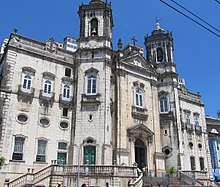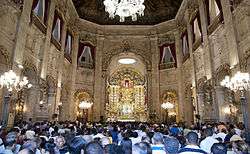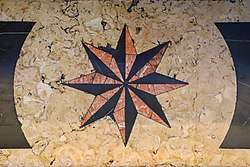Basilica of the Immaculate Conception, Salvador
The Basilica of the Immaculate Conception (Portuguese: Basílica Nossa Senhora da Conceição da Praia), or the Basilica of the Conception, is a church in Salvador, Bahia, Brazil. It is affiliated with the Catholic Church and was built in 1623, making it one of the oldest parishes in the Roman Catholic Archdiocese of São Salvador da Bahia.[1][2][3][4] It was the first church built by the first governor-general of Brazil, Tomé de Sousa. The current structure was prefabricated in Portugal and assembled in Salvador; its construction began in 1739 and ended in the mid 19th century. The art historian Germain Bazin classifies the church as Portuguese in design, rather than part of the Bahian tradition of religious structures of the 17th and 18th century.[5][6][7]
| Basilica of the Immaculate Conception | |
|---|---|
 Façade of Church of Nossa Senhora da Conceição da Praia | |
| Religion | |
| Affiliation | Catholic |
| Rite | Roman |
| Location | |
| Municipality | Salvador |
| State | Bahia |
| Country | Brazil |
 Location of the Basilica of the Immaculate Conception in Brazil | |
| Geographic coordinates | 12.975300°S 38.514290°W |
| Architecture | |
| Architect(s) | Manuel Cardoso Saldanha |
| Groundbreaking | 1739 |
| Completed | 1849 |
| Specifications | |
| Length | 56 metres (184 ft) |
| Width | 43.9 metres (144 ft) |
National Historic Heritage of Brazil | |
| Designated | 1938 |
| Reference no. | 122 |
Its monumental façade is a hybrid of Baroque and Neoclassical styles, and is based on church façades of the period in Portugal. The building was designed by Manuel Cardoso Saldanha; the master bricklayer and architect Eugénio da Mota prepared the stonework in Portugal and accompanied it to Salvador. Its elevation to the status of basilica took place in 1946. Pope Pius XII declared Our Lady of Conception the sole patron of the State of Bahia. Robert C. Smith described the structure as the "first and most complete expression in Brazil of the new Baroque style that succeeded Mannerism in Portugal in the early years of John V's reign."[8][6][7]
History

Early history
The present church structure is the third to be built on the site. Tomé de Sousa (1503-1579), the first governor-general of the Portuguese colony of Brazil, established a primitive settlement and chapel in 1549 on the site of the current church in the initial period of construction of Salvador. Father Manuel da Nóbrega (1517-1570) and six Jesuit clergymen personally built a small mud-walled chapel at the base of the slope between the current upper and lower city. The chapel was dedicated to Our Lady of the Conception and housed an image of the saint brought by Tomé de Sousa from Portugal. The site sits close to the oceanfront and was a place of worship for sailors and tradesmen arriving in Brazil; they christened the church the Conception of the Beach (Conceição da Praia), a name that remained during subsequent reconstructions.[9][10][11]
17th century
The growth of the population of the Cidade Baixa and area near the port of Salvador necessitated the construction of a larger church. Marcos Teixeira de Mendonça (1578-1624), a bishop and resistance leader against the Dutch attacks against Brazil, expanded the structure in 1623. It was renamed Matriz da Nova Freguesia de Nossa Senhora da Conceição da Praia and was financed by wealthy Portuguese merchants in the area.[10]
18th century
The Santíssimo Sacramento da Imaculada Conceição, a fraternal order, decided to completely rebuild the church in 1736. The military engineer Manuel Cardoso de Saldanha planned the church and Manuel Vicente, a master stonemason, supervised its construction. The master bricklayer and architect Eugénio da Mota prepared the lioz stonework in Portugal and accompanied it to Salvador. The import of lioz stonework from Portugal for use as architectural elements in Brazil began in the 16th century; it additionally served as ballast for Portuguese ships travelling to Brazil. The art historian Germain Bazin classifies it as the only Portuguese church in Bahia, and outside of the progression of design of other religious structures in the region.[5][12][6]
Construction on the church began in 1739 but was delayed in 1758 by a financial downturn in Bahia. The woodcarver Lourenço Rodrigues Lançarote completed the elaborate side altars in 1765; he had earlier completed similar work in the Church of the Third Order of Mount Carmel. João Moreira de Espírito Santo completed the high altar between 1765 to 1773. The new structure, still unfinished, was dedicated on December 8 of the same year by the Archbishop of Bahia, Frei Manuel de Santa Inês Ferreira (1704-1771). Eugénio da Mota returned to Lisbon in 1769, "aged and nearly blind".[8][12][6]
19th century
Four Portuguese masons succeeded Da Mota. The completion of the central section and left wing of the church in 1820 marked the end of major construction of the structure. By 1820 the fraternal order had spent 208,234,000 Portuguese réis on the church, making it one of the costliest in Bahia. The massive staircase in lioz and right wing of the structure were completed in 1850.[8][12][6][7]
The church of the Immaculate Conception received the title of minor basilica by the Apostolic Letter "Coruscantis sideris" of the 7 of October 1946, by decision of the Holy See.[12]
Location

The Basilica of the Immaculate Conception faces directly northwest onto the Bay of All Saints. After numerous additions to the port facilities of the area it now sits at the south the cidade baixa, or lower city. Parts of the church, notably the chancel, are built directly into the cliff that marks the cidade baixa.
Structure
The Basilica of the Immaculate Conception has a monumental façade of lioz, with straight lines and rectangular details. The façade is neoclassical with two diagonal towers which "give a baroque touch to the design of the church box."[7] The church is noted for its use of natural light: it has a copula above the chancel and faces directly west to utilize light from the Bay of All Saints via numerous doors and windows.[9][7]
Interior
The interior of the church is the first complete example of the Baroque style of John V of Portugal; it was partially altered in the Neoclassical style in the 19th century. The high altar is ornate, with monumental Solomonic columns, an altar in silver, and an image of Our Lady of the Conception at center. The master carver João Moreira do Espírito Santo completed the carving of the high altar in cedar between 1765 and 1773. Domingos Luiz Soares, among others, is responsible for the gilding of the high altar. The Italiante Solomonic columns, which feature flower garland and acanthus details, resemble those of the baldachin of St. Peter's Basilica. A copula and two massive oculi in the chancel ceiling provides natural light to the chancel and high altar. The ceiling of the nave in the Baroque illusionist style and executed by José Joaquim da Rocha (c. 1737-1807).[13][12][9]
Side chapels
The church has eight side chapels: three along each side of the nave and one at either side of the high altar. The chapel at the right of the higher altar is dedicated to the Holy Christ (Capela do Santo Cristo).
At the left of the nave, from left to right:
- Chapel of Saint Joseph (Capela de São José)
- Chapel of Our Lady of Sorrows (Capela de Nossa Senhora das Dôres)
- Chapel of Saint John the Baptist (Capela de São João Batista), with an image of Our Lady of Fátima below
At the right of the nave, from left to right:
- Chapel of Our Lady of the Rosary (Capela Nossa Senhora do Rosário), with an image of Saint Pantaleon below
- Chapel of Saint Anthony (Capela de Santo Antônio), with an image of Saint Joseph below
- Chapel of Saint Benedict (Capela de Sao Benedito)[10]
Patio
The church has an interior patio with a fountain and staircase leading to the meeting room of the Brotherhood. The patio and its elements are entirely constructed of lioz.[11]
Protected status
The Basilica of the Immaculate Conception was listed as a historic structure by the National Institute of Historic and Artistic Heritage in 1938. It is listed in the Book of Historical Works process no. 112-T, inscription no. 126.[13]
Access
The Basilica of the Immaculate Conception is located in the Comercio district near the Lacerda Elevator and Modelo Market and may be visited.
See also
- Roman Catholicism in Brazil
- Our Lady of the Immaculate Conception
References
- Vries, Alexandra de; Blore, Shawn (2012-04-24). Frommer's? Brazil. John Wiley & Sons. ISBN 9781118086063.
- Basilica of the Immaculate Conception
- Bahia, Instituto Genealógico da (2005-01-01). Revista do Instituto Genealógico da Bahia (in Portuguese). The Institute.
- Havik, Philip J.; Newitt, M. D. D. (2007-01-01). Creole Societies in the Portuguese Colonial Empire. University of Bristol, Department of Hispanic, Portuguese & Latin American Studies. ISBN 9780955392269.
- Bazin, Germain (1956). L'architecture religieuse baroque au Brésil (in French). 1. São Paulo: Museu de Arte. p. 142.
- Smith, Robert C. (1956). "Nossa Senhora da Conceicao da Praia and the Joanine Style in Brazil" (PDF). The Journal of the Society of Architectural Historians. 15 (3): 16–23. doi:10.2307/987761. JSTOR 987761. Archived from the original (PDF) on 2014-01-09. Retrieved 2017-02-17.
- Talento, Biaggio; Hollanda, Helenita (2008). Basílicas & capelinhas: um estudo sobre a história, arquitetura e arte de 42 igrejas de Salvador (in Portuguese). Salvador, BA: Bureau Gráfica. ISBN 9788585923228.
- Bazin, Germain (1956). L'architecture religieuse baroque au Brésil (in French). 2. São Paulo: Museu de Arte. pp. 23–24.
- Vilaron, André (2007). Igrejas históricas de Salvador = Historical churches in Salvador. Brasília, Brazil: Ministério das Relações Exteriores, Governo Federal. pp. 149–157. ISBN 9788560123001.
- Departamento de Cultura da Secretaria de Educação e Cultura da Prefeitura da Cidade do Salvador, ed. (1977). "15". Pequena guia das igrejas da Bahia (in Portuguese). Bahia: Prefeitura do Salvador. pp. 5–6.
- Tirapeli, Percival (1999). As mais belas igrejas do Brasil = The most beautiful churches of Brazil. São Paulo, Brazil: Metalivros. pp. 186–189. ISBN 8585371250.
- Lins, Eugénio Ávila (2012). "Church of Our Lady of the Conception of Praia". Heritage of Portuguese Influence/Património de Influência Portuguesa. Retrieved 2017-02-17.
- Carrazzoni, Maria, ed. (1980). Guia dos bens tombados (in Portuguese). Rio de Janeiro, RJ: EXPED-Expansão Editorial. p. 93. ISBN 9788520800577.
| Wikimedia Commons has media related to Nossa Senhora da Conceição da Praia Church (Salvador). |